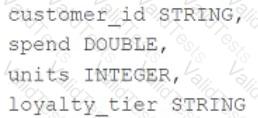
View all detail and faqs for the Databricks-Machine-Learning-Associate exam
Which of the following describes the relationship between native Spark DataFrames and pandas API on Spark DataFrames?
A data scientist has a Spark DataFrame spark_df. They want to create a new Spark DataFrame that contains only the rows from spark_df where the value in column price is greater than 0.
Which of the following code blocks will accomplish this task?
Which of the following is a benefit of using vectorized pandas UDFs instead of standard PySpark UDFs?
A data scientist has been given an incomplete notebook from the data engineering team. The notebook uses a Spark DataFrame spark_df on which the data scientist needs to perform further feature engineering. Unfortunately, the data scientist has not yet learned the PySpark DataFrame API.
Which of the following blocks of code can the data scientist run to be able to use the pandas API on Spark?
A data scientist uses 3-fold cross-validation when optimizing model hyperparameters for a regression problem. The following root-mean-squared-error values are calculated on each of the validation folds:
• 10.0
• 12.0
• 17.0
Which of the following values represents the overall cross-validation root-mean-squared error?
A data scientist has created a linear regression model that useslog(price)as a label variable. Using this model, they have performed inference and the predictions and actual label values are in Spark DataFramepreds_df.
They are using the following code block to evaluate the model:
regression_evaluator.setMetricName("rmse").evaluate(preds_df)
Which of the following changes should the data scientist make to evaluate the RMSE in a way that is comparable withprice?
A data scientist is developing a single-node machine learning model. They have a large number of model configurations to test as a part of their experiment. As a result, the model tuning process takes too long to complete. Which of the following approaches can be used to speed up the model tuning process?
A data scientist has produced three new models for a single machine learning problem. In the past, the solution used just one model. All four models have nearly the same prediction latency, but a machine learning engineer suggests that the new solution will be less time efficient during inference.
In which situation will the machine learning engineer be correct?
A machine learning engineer has been notified that a new Staging version of a model registered to the MLflow Model Registry has passed all tests. As a result, the machine learning engineer wants to put this model into production by transitioning it to the Production stage in the Model Registry.
From which of the following pages in Databricks Machine Learning can the machine learning engineer accomplish this task?
A data scientist is working with a feature set with the following schema:

Thecustomer_idcolumn is the primary key in the feature set. Each of the columns in the feature set has missing values. They want to replace the missing values by imputing a common value for each feature.
Which of the following lists all of the columns in the feature set that need to be imputed using the most common value of the column?